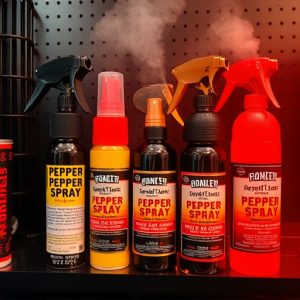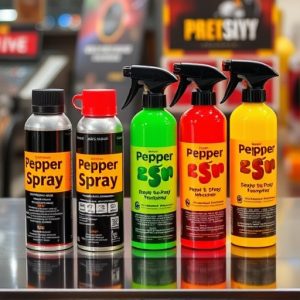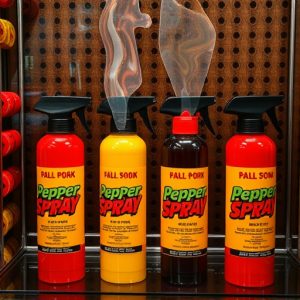Mastering Self-Defense with Pepper Spray Displays: A Comprehensive Guide
Pepper spray displays are critical for personal safety, offering non-lethal self-defense against as…….
Pepper spray displays are critical for personal safety, offering non-lethal self-defense against assault by emitting an Oleoresin Capsicum (OC) irritant that temporarily incapacitates attackers. These devices come in various forms, including keychain and law enforcement unit-dose systems, with features like clear viewing windows for monitoring spray levels and designs optimized for range, concentration, and effectiveness up to 10 to 15 feet. It's crucial to understand how to operate them properly, considering factors like aiming, deployment speed, and environmental influences such as wind. Regular maintenance and replacement of the pepper spray, in accordance with expiration dates, are necessary to maintain its potency. Training with these displays is important for enhancing their reliability as a personal protection measure. Pepper spray exhibits demonstrate its scientific basis and practical use by showcasing different formulations like stream, fogger, gel, and foam, each tailored for specific self-defense scenarios and legal considerations. Users should familiarize themselves with local laws regarding pepper spray use before selecting the appropriate type to ensure personal safety in various situations.
When considering personal safety, understanding the tools available for self-defense is crucial. Among these, pepper spray displays emerge as a reliable and effective deterrent against potential assailants. This article delves into the capabilities of pepper spray displays, offering an insightful look at their science, effectiveness, and legal implications. We will explore the key features to consider when selecting a high-quality pepper spray display, from the potency of its OC content to the type of aerosol it emits. Additionally, we’ll examine how these displays are used responsibly in real-life situations and the importance of training to ensure their efficacy. Join us as we navigate the world of self-defense pepper spray displays and empower you with knowledge to make informed decisions for your safety.
Understanding the Capabilities of Pepper Spray Displays: An Overview
When considering personal safety measures, understanding the capabilities of pepper spray displays is paramount. These devices are designed to deploy a powerful irritant, often Oleoresin Capsicum (OC), which can temporarily incapacitate an assailant. Pepper spray displays come in various forms, including keychain models, pocket sprays, and larger unit-dose systems suitable for law enforcement or institutional settings. The efficacy of these sprays lies in their range and concentration; they can effectively deter threats from a safe distance, often up to 10 to 15 feet, giving the user precious time to escape or seek help.
The design of pepper spray displays incorporates a clear viewing window that allows users to monitor the remaining contents without compromising the integrity of the spray unit until it’s needed for self-defense. This feature ensures that individuals are prepared and can verify their pepper spray is ready for use at a moment’s notice. Additionally, these displays often highlight the expiration date, promoting the regular replacement of the spray to maintain its potency. Understanding the operational aspects, such as aiming, deployment speed, and wind considerations, is also crucial when utilizing pepper spray displays. Proper training and familiarity with the equipment can enhance users’ effectiveness in self-defense situations, making these sprays a reliable tool for personal protection.
– The Science Behind Self-Defense Pepper Spray
Self-defense pepper spray is a non-lethal self-defense tool that incapacitates an attacker by causing intense irritation to the eyes, skin, and respiratory system. The active ingredient in these sprays, typically oleoresin capsicum (OC), triggers a reaction in the sensory neurons, leading to an overwhelming sensation of pain. This response is scientifically grounded in the way capsaicin, the compound responsible for the ‘heat’ in chili peppers, interacts with the TRPA1 receptor in the skin and mucous membranes. When deployed, the fine droplets of pepper spray penetrate into the eyes, face, and lungs of an assailant, causing immediate pain and disorientation. The effects are temporary but debilitating, providing the user with a critical window to escape or defend themselves until help arrives.
Pepper spray displays serve as a tangible demonstration of the product’s efficacy. Manufacturers often incorporate interactive exhibits that simulate the use of pepper spray, allowing potential customers to witness its potency firsthand. These displays are crucial for understanding the range and trajectory of the spray, which can vary depending on factors like wind conditions and distance from the target. By showcasing the dispersion pattern and effectiveness through these displays, users gain a practical insight into how the product functions. This not only educates but also reassures users about the reliability of pepper spray as a self-defense mechanism. The interactive nature of these displays complements the science behind pepper spray, reinforcing its role in personal safety strategies.
– Types of Pepper Spray and Their Effectiveness in Real-Life Situations
Pepper spray, a non-lethal self-defense tool, comes in various forms and concentrations, each tailored to maximize effectiveness in real-life situations. The most common types include stream, fog, gel, and foam sprays. Stream pepper spray delivers a narrow, directed flow that can target an attacker’s eyes from a distance of up to 10-15 feet, making it ideal for crowded spaces where precision is key. Fogger sprays, on the other hand, emit a dense cloud of pepper spray that spreads over a wide area, effective in scenarios where an assailant might be out of arm’s reach or if multiple attackers are present. Gel formulations offer a non-aerosol, sticky substance designed to stay on the target, ensuring the active ingredients penetrate protective eyewear and minimize the risk of drifting to bystanders. Lastly, foam pepper sprays provide a heavy mist that clings to the face and eyes of an attacker, reducing wind blow and creating a prolonged effect.
When evaluating the effectiveness of these pepper spray displays in self-defense scenarios, it’s crucial to consider their legal status, ease of use, and the specific conditions under which they are employed. High-quality pepper sprays typically contain oleoresin capsicum (OC), which induces a strong irritation to the eyes, skin, and respiratory system upon contact. This temporary incapacitation can provide a crucial window of opportunity for escape or to alert authorities. It’s important to familiarize oneself with local laws regarding the use of pepper spray, as it varies by state and country. In conclusion, the choice between stream, fog, gel, or foam pepper spray should be informed by individual needs, environmental factors, and legal considerations to ensure effective personal protection in a variety of situations.


